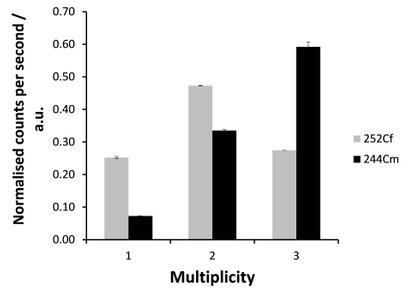Hybrid Instruments Ltd.
Real-Time Analysis
Multiplicity assay
Neutrons are emitted from fission events in synchronised groups, for example 235U emits an average of 2.5 neutrons per fission whilst 252Cf emits 3.8. Similarly, groups of gamma rays are emitted also; the radiation quanta emitted across a large number of fission events form a probability distribution which peaks at the average value and declines at high and low extremes. Groups of three and four neutrons at once are not unusual for most fissioning isotopes.
There are two specific advantages of the assessment of neutron (and to a lesser extent) gamma-ray multiplicity. Firstly, the probability of a chance interaction of uncorrelated coincidences of two, three and four neutrons is very unlikely and therefore if a detector system is capable of such an assay the noise associated with the measurement will be very low indeed. Secondly, the relative magnitude of correlated events (i.e. the size of doubles to triples, triples to quadruple events etc.) can be characteristic of a specific fissioning isotope. Moreover, uncorrelated neutron emitters such as (alpha,n) sources are easily discerned from correlated sources, enabling elementary chemical influences to be identified such as the mixtures of fissile material with light isotopes like plutonium fluoride and so forth.
The measurement of multiplicity is difficult with 3He detectors because the thermalisation step required introduces a long time delay during which many accidental contaminant events can be detected which degrade the refinement of the measurement.
With the Hybrid Instruments Ltd. mixed field analyser each discriminated neutron and gamma-ray event is processed in synchrony with the time it was detected.
Thus the discriminated events can be processed by a multi-channel coincidence unit to build multiplicity spectra out to the order of quadruples and quintuples.
Empirical multiplicity spectra (not unfolded) for 252Cf and 244Cm acquired with four EJ309 detectors.
Associated publications
A. Lavietes, M. Pickrell, R. Plentada, M. Mascarenhas, C. Liguori, M. D. Aspinall and M. J. Joyce. (2011)
Liquid scintillator neutron detection for real-time nuclear material assay. IEEE Nuclear Science Symposium.
M. J. Joyce. (2013)
Fast neutron multiplicity assay. Nuclear Future, Volume 9, Issue 6, ISSN 1745 2058, Pages 43-46.
K. A. A. Gamage, M. J. Joyce and F. D. Cave. (2014)
Sector-shaped fast organic liquid scintillation detectors based neutron coincident counter. App. Rad. and Isotopes, Volume 92, Pages 1-5.
M. J. Joyce, K. A. A. Gamage, M. D. Aspinall, F. D. Cave and A. D. Lavietes (2014)
Real-time, fast neutron coincidence assay of plutonium with a 4-channel multiplexed analyzer and organic scintillators. IEEE Transactions on Nuclear Science, Volume 61, Issue 3, Pages 1340-1348.
M. J. Joyce, M. D. Aspinall, F. D. Cave and A. Lavietes. (2014)
A 16-channel real-time digital processor for pulse-shape discrimination in multiplicity assay. IEEE Transactions on Nuclear Science, Volume 61, Issue 4, Pages 2222-2227.

